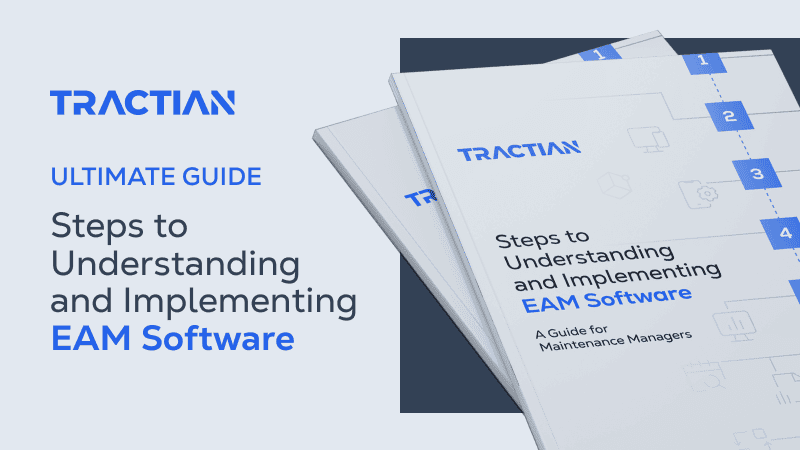Maintenance in the food industry? That’s a challenge. We know, keeping your food processing equipment running smoothly is no easy feat. Balancing strict hygiene, ever-evolving regulations and the constant pressure to avoid costly downtime is enough to keep any manager on edge.
Just think about it: downtime alone can steal 5% of your factory’s productivity, with some businesses losing a whopping 20%.
Even scarier, a study by the International Society of Automation (ISA) found that a shocking 80% of facilities have no clue what their total downtime cost (TDC) truly is, often underestimating it by 200-300%.
But it’s not just the lost time that hurts - it’s the hidden costs lurking beneath the surface, silently chipping away at your efficiency and profits.
The solution? Enter TRACTIAN.
Our CMMS (with EAM muscles) is specifically engineered to help organizations overcome the challenges of maintenance in the food industry.
Imagine it as your strategic ally, empowering you to conquer downtime, ensure regulatory compliance, and navigate the complexities of food safety regulations with ease.
Ready to ditch the stress and unlock the secrets to maintenance mastery? Let’s dive into 7 practical strategies for ensuring a bulletproof operation.
1. Implementing a Preventive Maintenance Program
Why wait for a machine meltdown when you can prevent it?
In the food industry, where reliability and safety are non-negotiable, breakdowns are more than just an inconvenience, they’re a gamble with your entire operation (and maybe even customer trust).
Do you know what the real shocker is? Processing Magazine says most unplanned downtime comes from equipment meltdowns (42%), operator errors (19%), and - surprise, surprise - poor scheduling maintenance (13%).
The solution? A rock-solid Preventive Maintenance (PM) program.
Forget the fire drills and the scrambling of reactive repairs. PM is all about making sure every machine is a well-oiled, safety-approved asset in your production chain.
We’ve already set a complete guide showing you how to create a comprehensive maintenance plan, check it out!
But here’s the best part: imagine having a platform that takes PM from “to-do list” to “done deed,” automatically scheduling tasks and tracking every wrench turn with laser focus?
That’s TRACTIAN’s magic - it’s like having a manager taking care of each part of your machinery, ensuring PM happens on time, and efficiently.
Experience Uninterrupted Maintenance Excellence
2. Emphasizing Hygiene and Sanitation in Maintenance Practices
Since we’re talking about maintenance in the food industry, you must know this: hygiene and sanitation are essential ingredients for food safety and public health.
Tell us: where do these two concerns stand on your priorities list? If it’s not at the top, let’s recalibrate.
Hygiene and sanitation aren’t just about ticking boxes for compliance.
But how do we make these practices more than just a checklist? How do we turn them into habits ingrained in the daily grind?
This is where TRACTIAN’s solutions shine, not by overshadowing your expertise but by supporting your commitment to excellence.
Its features make scheduling and tracking cleaning and sanitizing activities easy, ensuring every corner is clean and every machine gets the attention it needs.
Suddenly, compliance with hygiene standards transforms from a chore into a badge of honor - a sign that your operation prioritizes safety above all else.
3. Leveraging IoT for Real-Time Equipment Monitoring
Imagine harnessing the power of foresight to predict your equipment’s health before it throws a wrench in your operations.
That’s the transformative potential of real-time IoT monitoring and IoT-powered maintenance in the food industry.
It’s not about some dystopian scenario, but rather gaining an intimate understanding of your machinery’s every whisper, every tremor.
By continuously monitoring performance and condition, you transition from reactive crisis management to proactive prevention, effectively nipping potential breakdowns in the bud.
Think of TRACTIAN’s IoT sensors as your silent sentinels, meticulously investigating the faintest signs of trouble before they escalate into costly disruptions.
More than passive observers; they are designed to act like proactive guardians, safeguarding your operation from unseen threats lurking in the shadows.
The tangible benefits?
Minimized downtime, reduced contamination risk, and the invaluable peace of mind that comes with knowing your equipment is operating harmoniously.
4. Adhering to Regulatory Compliance through Maintenance Records
Navigating the ever-evolving labyrinth of food industry regulations it’s a big challenge. Why? Dedication alone isn’t enough; you need meticulous documentation, each maintenance log acting as a vital stamp of compliance during audits.
The true challenge lies in ensuring these records are meticulously maintained and readily accessible.
Can you tell us if your current maintenance philosophy - and software - help your company with this?
Well, TRACTIAN’s solution ensures your logs are accurate, up-to-date, and easily accessible, transforming the once-tedious task of record-keeping into a smooth and efficient journey.
Whether facing a routine inspection or an unexpected audit, having a digital logbook at your fingertips not only demonstrates compliance but also weaves a compelling narrative of your unwavering commitment to the highest standards.
Oh, and you know what? This also helps in your ESG efforts.
Efficient record management minimizes paper waste and streamlines processes, reducing your environmental footprint.
Additionally, ensuring the health and safety of your equipment through proactive maintenance practices lowers energy consumption and reduces the potential for contamination, fostering a more sustainable operation.
Also, transparent and readily available documentation fosters trust and accountability, strengthening your social responsibility narrative.
This way, you’re not just filing records, but solidifying your position as a leader in responsible food production.
5. Training Staff on Maintenance Best Practices
Since we’re analyzing how maintenance in the food industry works, you should already know: safety and efficiency are non-negotiables.
So, empowering your team with cutting-edge maintenance practices is crucial.
But how do you bridge the gap between training manuals and real-world application?
This is a real challenge many of our peers face - and the reason why we worked so hard on our solution to, also, guide your team to seamless knowledge transfer and skill development.
Beyond just managing tasks, our CMMS platform fosters engagement and empowerment.
It facilitates the seamless sharing of best practices, tips, and safety protocols within your team’s daily workflow.
This way, training transforms from a one-time event into an ongoing journey of continuous learning.
Staff can access a wealth of information, learn from past experiences, and stay abreast of the latest safety protocols, right at their fingertips.
This continuous knowledge loop empowers every team member to become a well-informed guardian of your machinery’s health and safety.
Our goal is that, with TRACTIAN, you can cultivate a culture of continuous improvement and proactive safety, where best practices are not just followed, but ingrained in your team’s DNA.
6. Optimizing Maintenance Scheduling to Minimize Production Disruption
Imagine your production line as a well-oiled machine, churning out quality products at full speed. That’s peak maintenance in the food industry scenario, right?
Now, picture the inevitable PM breaks - essential for keeping everything running smoothly, but potentially disruptive if not planned strategically.
The key to minimizing disruption lies in optimizing your scheduling.
But… How? Here are some key strategies:

This is where TRACTIAN’s maintenance management software comes in handy.
Think of it as your answer for precision planning.
Our platform analyzes your production data, identifying optimal windows for maintenance based on historical trends and planned downtimes.
It also facilitates seamless communication by providing a centralized platform for sharing PM schedules and updates.
Remember, the goal isn’t just to avoid disruption, but to synchronize maintenance in the food industry with your production flow.
By carefully planning and leveraging the right tools, you can ensure your PM breaks become seamless transitions, allowing your production line to keep hitting the right notes without missing a beat.
7. Utilizing Predictive Maintenance for Proactive Equipment Care
Remember that sinking feeling when a key piece of equipment decides to throw a tantrum mid-production? It’s a recipe for headaches (and downtime).
But what if you could predict these meltdowns before they happen?
Enter predictive maintenance in the food industry, a game-changer that shifts your focus from reactive repairs to proactive care.
New to this concept? Think of it as a combination of data analysis and predictive techniques that whisper about potential equipment issues before they escalate into full-blown failures.
But how can your company make this a reality?
That’s what the TRACTIAN’s ecosystem of maintenance management and monitoring solutions essentially does.
By analyzing data like vibration, temperature, and historical performance, TRACTIAN detects subtle shifts that warn of impending trouble.
All of this is in a centralized dashboard, with real-time status updates about your entire factory - or a specific machine. It’s your choice.
This empowers you to intervene early, taking preventive measures like scheduling maintenance or replacing worn-out parts before they cause critical breakdowns.
Think of it like taking your car for regular checkups instead of waiting for it to break down on the highway.
It’s about minimizing disruption, extending equipment lifespan, and ultimately, keeping your production line humming smoothly.
But predictive maintenance in the food industry isn’t just about avoiding headaches - it’s about optimizing your bottom line.
Imagine the cost savings from reduced downtime, minimized repair expenses, and improved equipment longevity.
Plus, by focusing on preventive measures, you’re creating a safer work environment and reducing the risk of unexpected equipment failures.
So, what about embracing the power of prediction?
With TRACTIAN’s solutions, you can shift from scrambling to fix problems to confidently anticipating and preventing them.
Case Studies: Success Stories in the Food Industry
Did you know that TRACTIAN helped a beverage to battle costly downtime due to bearing issues?
Many food industry players face similar challenges, where unexpected equipment failures can wreak havoc on production and profits.
The thought was: “what if we could predict these problems before they strike?”
That’s exactly what TRACTIAN helped this leading manufacturer achieve.
By deploying 31 of our intelligent sensors across their critical equipment, we transformed their maintenance approach from reactive to proactive.
The results? A game-changer.
Not only did unplanned downtime plummet by 30%, but equipment reliability skyrocketed by 45%.
In just one year, they saved a staggering $118,000 - a testament to the power of predictive maintenance in the food industry, agree?
But, hey… The story doesn’t end there.
Impressed by these results, the company expanded TRACTIAN’s solution across multiple plants, solidifying their commitment to optimizing operations and safeguarding equipment health.
This is just one example of how TRACTIAN empowers food industry leaders to transform their maintenance practices.
From minimizing downtime and maximizing production to reducing costs and ensuring compliance, our solutions deliver real, tangible results.
Want to see your own success story unfold? We’re here to help you leverage the power of data and insights to gain a competitive edge in the ever-evolving food industry.
Conclusion
So, about maintenance in the food industry, the key is to remember that (and work towards reality where) safety, efficiency, and compliance are non-negotiables.
Oh, and most importantly, that smart strategies are your recipe for success.
Here, we’ve explored proactive approaches like optimized scheduling and predictive maintenance - powerful tools to minimize downtime, maximize equipment lifespan, and keep your production line humming smoothly.
Remember, consistent, data-driven maintenance isn’t just about fixing problems; it’s about preventing them.
By taking a proactive approach, you safeguard your workers, ensure product quality, and stay ahead of regulatory hurdles.
Now, are you ready to elevate your maintenance game?
TRACTIAN can be your partner in achieving operational excellence. Our industry-specific solutions empower you to streamline processes, optimize scheduling, and leverage the power of predictive analytics.
Don’t wait for disruptions to dictate your story.
Explore how TRACTIAN can help you write a new chapter - one filled with proactive care, maximized uptime, and a commitment to the highest standards. Contact us today and unlock the full potential of your maintenance practices.


